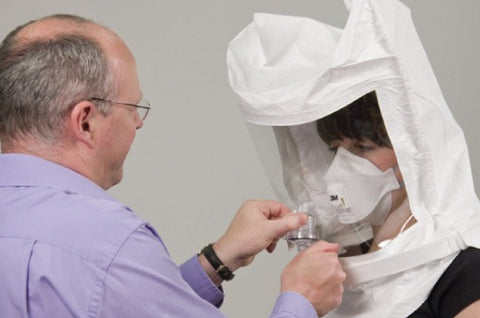Respirator Fit Testing (Qualitative vs Quantitative)
Full face masks, half face masks, N95 disposable respirators – which test to do when?
Respirator fit testing and certification are required for all workers that are susceptible to work environments with fine particles hazards that include haze, toxic fumes, asbestos, viruses, among others as outlined in the Workplace Safety & Health (WSH) Act. It is the employer’s responsibility to ensure that their workers are fit for work in these conditions while wearing suitable protective equipment or respiratory protection.
Workers with respiratory related medical issues must not be allowed to work in conditions where negative pressure respirators are required. For those who can work with a respirator, it is imperative that the fit of the respirator/mask fits perfectly without leaking.
There are 2 methods of ensuring a good fit:

Qualitative Fit Testing |
Quantitative Fit Testing |
|
|---|---|---|
 |
 |
|
| Method | Using taste, smell, or irritation test agents to determine leakage due to a bad fit |
3 Methods: |
| Tools (Equipment) | Fit test kit with hood, nebulizers & test solutions, for example: PROchoice Qualitative Fit Test Kit | Specialised Machinery (Quantifit2, PortaCount, etc) |
| Mask Compatibility | - Half face respirators - Disposable respirators (N95, FFP2, etc.) |
- Half face respirators - Full face respirators (including SCBA / Airline supply respirators) - Disposable respirators (N95, FFP2, etc.) – Only for certain test methods |
| Results | Pass or fail only, does not generate a number for fit level | Generates a number for the fit level (fit factor) |
| Cost | $ | $$ |
| Considerations | - Nature of test is subjective – ability to detect the test solution varies from person to person - Fast (Multiple people can be tested at once) - Errors can be made on the side of both the tester and the test subject during the test |
- Automated procedure reduces chance of human error during testing - Slower (One test subject at a time. They also require training to familiarize with test procedures) - There are pros and cons for each method of testing - The equipment and procedures are different for each method |


Which quantitative test method is best?
There are 2 main methods of quantitative fit testing that are largely approved. They are Ambient aerosol and controlled negative pressure. The table below outlines the differences:

Both test methods listed above will give similar fit factor results, however it is our view that controlled negative pressure testing is preferred as it tests each person’s personal respirator to ensure that the mask they use during work is fitted correctly and is keeping them safe. The CNP method can also be easily done anywhere on the worksite no matter the air quality or surrounding objects for the particles to cling to, which will affect AA test results.
Watch this video to get an idea of the Quantitative Respirator Fit Testing:

The graphic below outlines the standard procedure to get your staff fit tested and trained to correctly use the right mask for the job.

Step 1:
Please click here to see the range of respiratory protective equipment we have to offer. If you require any assistance, please call 8751 4546 or email us at sales@safetysolutions.com.sg and our friendly and informed sales team will help find you the perfect mask for your needs.
Step 2:
Once you have determined the right respirator for you, you can contact us for a quote. The price of the fit test will depend on the type of test, type of respirator, number of people, the test venue and number of sessions.
Step 3:
The test will be carried out by our certified trainers either on-site at your preferred address or at our offices at 998 Toa Payoh North, #03-14/15, Singapore 318993.
Step 4:
Individual certificates will be provided to each participant in the form of a paper certificate, soft copy PDF, or an individualized wallet sized card.

